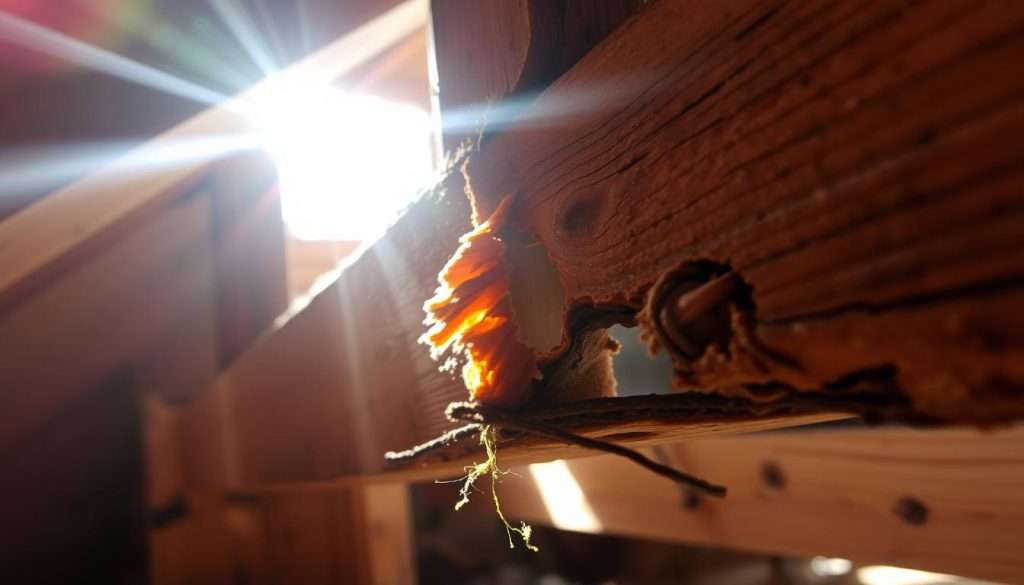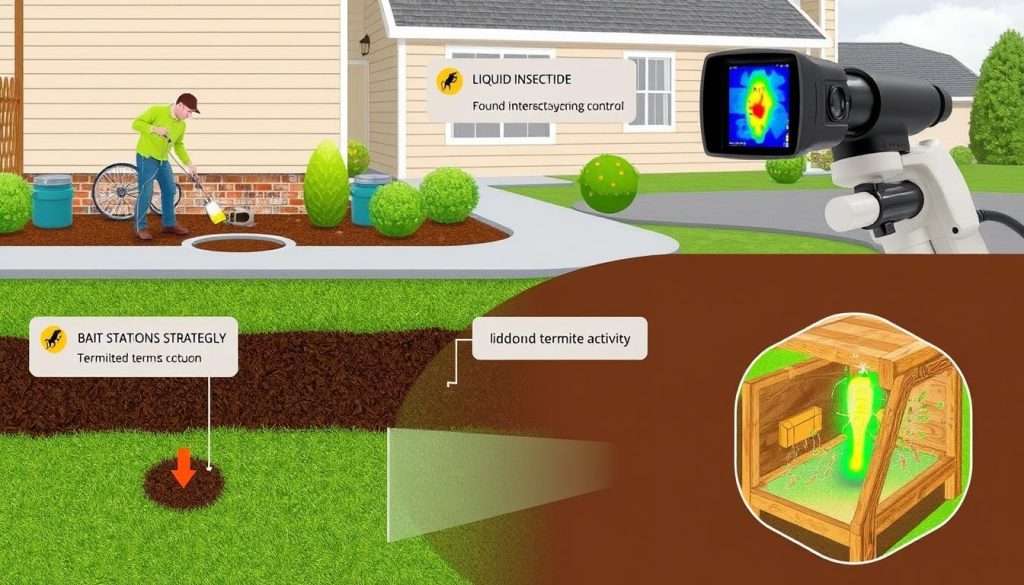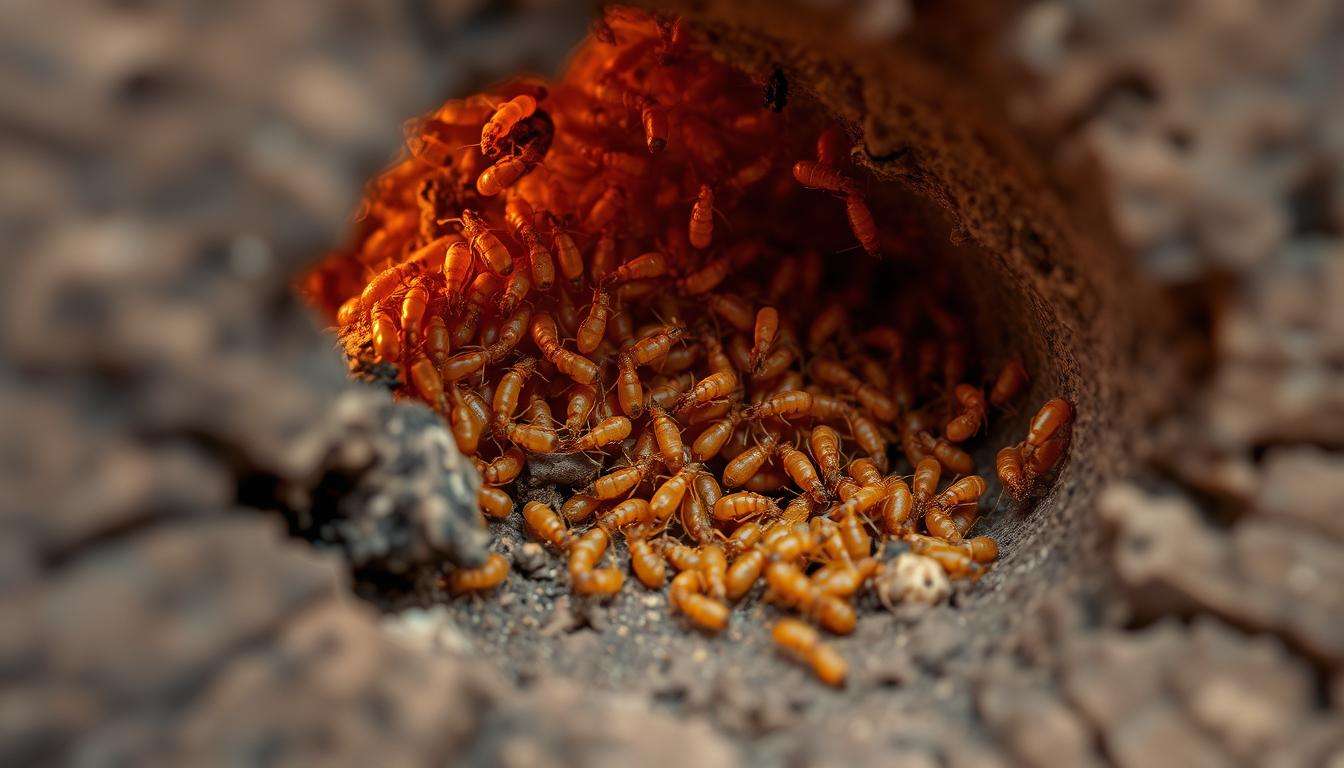Are termites dangerous to humans? Homeowners often worry about these pests. They mainly cause wood damage. But, it’s key to know the health risks of termites.
We’ll look at termite behavior and their habitats. This guide will help you understand termite health risks. You’ll learn how to prevent termites and keep your home safe.
Knowing how termites work helps you protect your home. It makes you feel safer in your space. You can take steps to avoid termite problems.
Key Takeaways
- Termites do not feed on human blood, making bites rare and typically not harmful.
- Termite infestations can exacerbate asthma due to mold and dust buildup.
- They can spread fungal spores leading to respiratory infections in sensitive individuals.
- Severe infestations can weaken structures and lead to potential injuries.
- Proper termite prevention measures can mitigate risk effectively.
- Annual inspections by professional pest control services are recommended.
- Stress and financial concerns related to termite damage can affect well-being.
Understanding Termite Behavior and Habitats
Termites are fascinating creatures that play critical roles in their environments. They have different types and organize their communities in complex ways. Termite colonies can have a few hundred to millions of termites. This helps them thrive in various habitats, creating unique ecosystems.
Types of Termites
Termites fall into three main categories, each adapted to specific environments:
- Drywood Termites: Common in southern U.S. regions, they prefer decaying wood, often establishing nests in wooden furniture and structures.
- Dampwood Termites: They thrive in moist areas and typically infest logs and stumps, moving to structures when conditions are favorable.
- Subterranean Termites: The most destructive type, they live in soil and can form colonies containing up to 2 million individuals. These termites are widespread across the U.S. and are known for their ability to create mud tunnels.
Termite Colonies and Structure
Termite colonies are highly organized, with different castes performing specific roles. The queen, workers, and soldiers work together to ensure the colony’s survival. Swarming is a typical behavior, where winged termites leave the nest to mate and establish new colonies.
Drywood termite colonies produce fewer swarmers, but subterranean termites can generate thousands during mating season. The presence of mud tubes is a telltale sign of subterranean termite activity, indicating a current or past infestation.
How Can Termites Damage Homes?
Termites can cause a lot of damage to homes. This damage can lead to expensive repairs. In the United States, termites cause over $5 billion in damage each year.
It’s important to spot signs of termite activity early. This can help prevent big problems from wood damage from termites.
Impact of Termite Infestations on Property
Termites love to eat wood, which can harm a house’s structure. They can damage homes made of materials other than wood too. Damage often shows up late, making homes unsafe.
Fixing the damage can be very expensive. Ignoring the problem can make things worse. Here’s what can happen:
| Type of Damage | Description | Possible Repair Costs |
|---|---|---|
| Structural Damage | Compromised foundation, ceilings, and walls | $4,000 – $20,000+ |
| Furniture Damage | Destruction of wooden furniture and fixtures | $500 – $5,000+ |
| Cosmetic Damage | Visible signs like staining and bubbling paint | $200 – $2,000 |
Common Signs of Termite Activity
Spotting signs of termite activity is key to avoiding big problems. Look out for these signs:
- Mud tubes on foundation walls
- Hollow-sounding wood when tapped
- Discarded wings from swarming species
- Sawdust-like droppings near wooden structures
- Visible tunnels in walls or furniture
These signs are warnings. Act fast if you see any wood damage from termites. For help, call a pest control service. They can prevent more damage and health risks. Learn more about termites here: detailed resource.

Are Termites Dangerous to Humans?
Termites are known for damaging wood, but are they harmful to humans? The answer is mostly no. They don’t usually bite people. Let’s look at what happens if they do and the health risks they pose.
Termite Bites: What to Expect
Termite bites are rare. These insects don’t look for blood. If they do bite, it’s usually just a small irritation.
People might see small red bumps. But the pain is usually not bad. Soldier termites can bite, but many bites don’t leave marks.
Indirect Health Risks Associated with Termites
Termites can also harm us in other ways. They can cause mold and mildew in homes. This can lead to health problems.
- Headaches
- Runny nose
- Itchy eyes
- Coughing
- Sore throat
Some people might get chronic nasal stuffiness or throat irritation. This could mean there’s mold, which termites help grow. It’s key to check for signs of termites to avoid health issues.
Termite damage costs U.S. property owners over $5 billion a year. This damage is not just about money. It’s about the harm termites can do to your home. Regular checks can help prevent this damage.
| Health Impact | Symptoms | Source of Issue |
|---|---|---|
| Mold Exposure | Headaches, sneezing, coughing | Termite infestations |
| Skin Irritation | Red bumps, itching | Termite bites |
| Respiratory Issues | Wheezing, runny nose | Mold growth |
In summary, termite bites are rare and usually don’t hurt much. But the health risks from termites are real. Homeowners should protect their homes to avoid damage and health problems.
Health Risks Related to Termite Infestations
Termite infestations can harm your health as well as your home. They can cause skin allergies and serious breathing problems. It’s important to know these risks.
Skin Allergies and Reactions
Being allergic to termites can cause skin problems. You might get itchy, swollen, or red. These symptoms can be uncomfortable.
- Itching
- Swelling
- Redness
Contact dermatitis from termites can hurt a lot. It’s a serious issue that needs attention.
Respiratory Issues and Asthma Concerns
Termites can make mold, which is bad for your breathing. You might feel sick or have trouble breathing. These problems can be serious.
- Migraines
- Runny nose
- Coughing
- Conjunctivitis
- Chronic asthma attacks
Children and people with weak immune systems are at higher risk. Knowing these risks helps you take action.
Potential Risks from Fungal Infections
Moisture from termites can grow mold. This can lead to fungal infections. These infections can cause allergies and breathing problems.
- Increased risk of allergic reactions
- Complications from existing respiratory conditions
- Immune system challenges leading to more significant health problems
| Health Issue | Symptoms | At-Risk Groups |
|---|---|---|
| Skin Allergies | Itching, swelling, redness | Individuals sensitive to allergens |
| Respiratory Issues | Migraines, runny nose, coughing, asthma | Children, elderly, immune-compromised individuals |
| Fungal Infections | Allergic reactions, breathing difficulties | Those with respiratory conditions |
Preventing Termite Infestations
Keeping termites away is key to your home’s safety. Using good termite prevention tips can lower the chance of them showing up. Simple steps to stop termites include being ready and watching for things that draw them in.
Effective Termite Prevention Tips
Here are some tips to keep termites out of your home:
- Make sure water doesn’t gather near your foundation.
- Fix any holes in walls and around doors and windows.
- Keep firewood far from your house to keep insects away.
- Clean your gutters often to stop water from building up.
- Try using orange oil and neem oil to keep termites away.
Key Steps in Home Maintenance
Regular checks are important to keep termites from your home. Look for signs like:
- Winged termites flying around
- Mud paths up your foundation
- Wood that sounds hollow
- Paint that’s cracked or peeling
Early detection can save you a lot of money. Think about using barriers like stainless steel mesh to block termites. For more tips, check out this page.
Termite Control Methods and Extermination
Understanding termite control is key. You have DIY options and professional extermination. Each has its own benefits. The right choice can make a big difference.
DIY vs. Professional Termite Control
Homeowners often pick DIY termite solutions for ease and cost. They include:
- Baiting stations that attract termites and gradually eliminate them.
- Regular inspections to detect early signs of termite activity.
These DIY methods can help but might not last long. For serious problems, professional help is needed. Experts use:
- Liquid termiticides applied directly to soil or wood for targeted treatment.
- Fumigation, which effectively eradicates heavy infestations through gas-based termiticides.
Professionals ensure a complete treatment and protect against future infestations.
Common Extermination Techniques
Termite extermination uses various methods. Each is chosen based on the property’s needs. Here are some common ones:
| Extermination Technique | Description | Effectiveness |
|---|---|---|
| Liquid Termiticides | Applied to soil and wood, targeting termites directly and disrupting their nervous system. | High; quick action within 24-36 hours. |
| Bait Stations | Termite bait placed around the foundation that takes time to eliminate the colony. | Moderate; full eradication may take up to 6 months. |
| Fumigation | Gas-based treatment for severe infestations requiring full evacuation of occupants. | Very High; effective for large infestations. |
Regular checks are vital for keeping termite control methods working. Each method aims to protect your home and keep it safe.

Conclusion
Termites might not spread diseases, but they can still harm your health and home. They cause billions of dollars in damage each year. Many insurance plans don’t cover these losses.
Termites can also lead to breathing problems, skin allergies, and asthma attacks. This is because they can make mold grow in damp places.
It’s important to know how to stop termites from getting into your home. Regular checks and upkeep can help. This way, you can keep your space safe.
Termites are good for the environment, but they can make indoor air worse. Being ready and informed is key to fighting these pests.
Even though termites don’t bite, having them around is still a big problem. By taking action, you can protect your health and home. Knowing what to do is your strongest defense.
